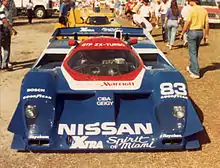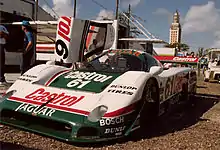IMSA GTP
Grand Touring Prototype (GTP) is the name of a former classification designated to sports prototypes in sports car racing competing in the IMSA GT Championship, maintained by IMSA between 1981 and 1993.[1][2] The early cars were based on the almost same identical ruleset as the FIA's Group C category, but eventually evolved into a separate category. It was the successor to the Grand Touring Experimental (GTX) class, which were based on FIA Group 5 and Group 6 cars.[3][4][5]







The IMSA GTP moniker was revived in 2023 to replace DPi as the top class of the IMSA SportsCar Championship for the merger of DPi and the World Endurance Championship Hypercar class.
History
GTP era
.svg.png.webp)

In 1981, purpose-built GTP cars (Grand Touring Prototypes) appeared in the championship, and were similar to the new FIA Group C cars which would be introduced to the World Endurance Championship from 1982. The main difference between the two categories was that the former had no emphasis on fuel consumption which was highlighted by Derek Bell saying "Race fans do not come to races to watch an economy run."[6] Brian Redman was the first GTP champion, driving a Lola T600 with a Chevrolet engine. March also fielded prototypes, with Al Holbert winning the 1983 championship with a Chevrolet powered car, changing to Porsche power later in the season; and Randy Lanier a year later with Chevrolet power. 1984 also saw the introduction of the Porsche 962, which dominated the series from '85 to '87. Nissan then took control of the series in 1988, but faced challenges from Jaguar, Porsche, and Toyota throughout the next three years. Toyota was quickest in 1992 and 1993, at the end of the GTP era, as Dan Gurney's All American Racers team campaigned the Eagle Mk III, a car so dominant that it has been blamed for the demise of the class. Along with the GTP cars, the Camel Lights cars, a smaller capacity, non-turbocharged, lower powered prototype category was introduced in 1985. Argo Racing Cars was the first 'Lights' Champions, followed by Spice Engineering. Other well known participants were the Tiga, Royale, Alba, Fabcar, and Kudzu.
Starting with the 1986 season, the GTP category had their own decal, which was similar to the IMSA GT side decal, with a P being added to denote their category.[7] Camel Lights cars also used the same decal[8]
There were many other manufacturers in the GTP class, such as URD Rennsport, Spice, Intrepid or Gebhardt, and in the early 1990s, Mazda.
Fall of GTP
Following a successful heart surgery in 1987, Bishop began to rethink his priorities. He was approached by Mike Cone and Jeff Parker, owners of Tampa Race Circuit. In January 1989, Bishop and France sold the series to Cone and Parker. The new owners relocated the IMSA headquarters from Connecticut to Tampa Bay.[6] Bishop would stand down as president in favor of Mark Raffauf, who was his deputy, and its representative on the ACCUS board.[9] Cone and Parker sold it to businessman Charles Slater. Both lost millions attempting to revive the sagging TV ratings.[6]
By 1992, there were a number of factors that led to the decline of the GTP category. Porsche concentrated on its IndyCar(Porsche 2708)program when critics stated that the Zuffenhausen marque should have built a followup to its 962.[6] Back in 1988, Al Holbert realized that the 962 was beginning to feel dated. He proposed a follow-up open-top Porsche powered racer which would also be sold to customer teams. That project never got off the ground due to Holbert's death in an aircraft accident later in the year.[6] For some, much of the blame was on the organization for allowing the Japanese "works" teams to dominate the series. Under Bishop's original vision, privateers and "works teams" were able to race equally. Privateer teams walked away, while the Japanese economy started to go downhill. These factors led Nissan and Mazda to leave the series. Critics predicted that the decreased variety of cars would disappoint race fans, and in fact, it did finally kill the series in 1993.[6] GTP cars ran their last race on October 2, 1993, at Phoenix International Raceway.[10]
The GTP category was credited for many innovations in the U.S., including antilock brakes, traction control, and active suspension.[6] Dave Cowart and Kemper Miller's Red Lobster sponsored team of the early 1980s would innovate race team hospitality, practices which were subsequently adopted by virtually every other team.[6] For those that competed, GTP was recognized for its camaraderie among drivers, especially rivals. But Hans Stuck, commenting in the foreword of the book "Prototypes: The History of the IMSA GTP Series", sarcastically compared the series' camaraderie to Formula One's lack of such.[6]
References
- "IMSA Archives - International Motor Racing Research Center". www.racingarchives.org.
- Quiniou, Louis (March 14, 2016). "#Focus – The IMSA GT Championship Story".
- "An introduction to the IMSA GT Championship (part 1) #blogpost". Car Throttle.
- "The Story of Mazda's Success in the IMSA GT Championship". Car Throttle.
- "IMSA GTU Division Featured Close Competition". May 26, 2016.
- Prototypes: The History of the IMSA GTP Series, J. A. Martin & Ken Wells, David Bull Publishing, ISBN 1-893618-01-3
- Photo by courtesy of: Fred Lewis Photos. "Daytona 24 Hours 1986". Racing Sports Cars. Archived from the original on 2016-03-03. Retrieved 2014-06-23.
- Photo by courtesy of: Michael O. Crews. "Daytona 24 Hours 1986". Racing Sports Cars. Archived from the original on 2016-03-03. Retrieved 2014-06-23.
- Endurance Racing 1982-1991, Ian Briggs, Osprey Automotice, ISBN 1-85532-228-5
- Michael Strahan (December 1993). "The Last Race". Car Magazine. Archived from the original on 2007-07-04. Retrieved 2007-05-15.
